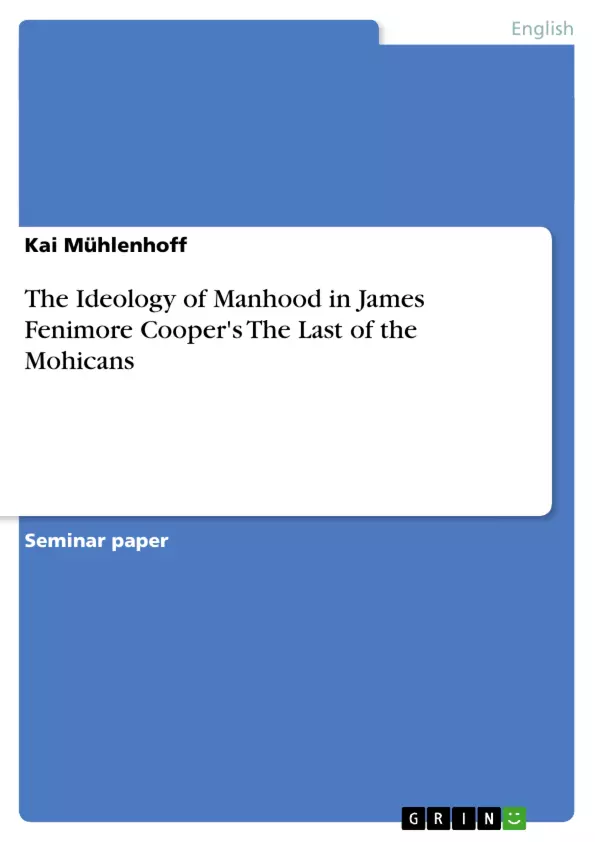My research paper is designed to clarify the aspects central to the issue of manhood negotiated in James Fenimore Cooper’s novel The Last of the Mohicans (1826).
In the Victorian era, manhood had been positively attributed to the white race exclusively. In novels and illustrations, the ideal man fit the “Victorian ideals of manhood” (Rotundo 37-40) with fixed traits and attributes, such as courage, sexual self-restraint, a powerful will, and a strong character. As we will see, no male in the novel fits such a formula completely. I will then postulate what drives Cooper to bestow such an image on his male heroes.
The “Victorian ideals” did not apply to all male people. “Savage” men, as Uncas and his father in the novel, were not considered to possess the distinct traits attributed chiefly to non-savage men, i.e. the white-male. Manliness was clearly linked to white-male supremacy and civilization; a long-held belief in American culture for centuries. The encounter between the “uncivilized brutish” and the whites is a dominant theme in the novel. We will see that the combining issue of race, gender, culture and civilization is inextricable and fundamental for the study of the subject and therefore will be elaborated on in detail.
Many historians have falsely assumed that manhood has a strict, self-evident set of traits, unchanging over time. Other historians have emphasized the fact that the set of traits attributed to manhood varies from period to period, from class to class. This lead to a continual need for redefining male character traits at any historical moment, which often problematically presented itself in coexisting but contradictory views on manhood at a special period.
Cooper, of course, was deeply familiar with the period’s masculine ideal of manhood, and understood that Victorian readers expected to find these qualities of manliness assigned to his male characters. Indeed, these attributes are present in the white male figures in the novel, but more importantly, Cooper does not hesitate to display an image of white men that portrays male deficiency in various aspects and situations. In chapter III. and IV., this issue is discussed in detail.
Inhaltsverzeichnis (Table of Contents)
- I. Introduction
- II. The Connotations of manhood, manliness and masculinity
- II.1 Manhood and Manliness
- III. Race, Gender and Civilization
- III.1 Powerful Manhood and White Supremacy
- III.2 Civilization in Terms of Gender Differences
- III.3 Natty "Hawk-eye" Bumppo – a New Kind of Man in the Making
- III.4 Heyward as the Anxious, "passive hero"
- IV. Defining the American Frontier Hero
- IV.1 Heteroglossia in The Last of the Mohicans
- IV.2 The Love between Chingachgook and Hawkeye
- IV.3 Civilization and the Birth of a New Man
- V. Conclusion
Zielsetzung und Themenschwerpunkte (Objectives and Key Themes)
This research paper aims to investigate the complexities of manhood as portrayed in James Fenimore Cooper's novel, The Last of the Mohicans (1826). It explores how the Victorian era's ideal of manhood, typically attributed to the white race, is challenged and redefined through the portrayal of diverse male characters. The paper examines the interplay of race, gender, and civilization in shaping the concept of manhood within the novel.
- The evolution and complexities of defining manhood in the 19th century
- The relationship between race, gender, and civilization
- The role of heteroglossia in shaping the narrative of manhood
- The creation of a new American frontier hero
- The portrayal of male deficiency in various aspects and situations
Zusammenfassung der Kapitel (Chapter Summaries)
- I. Introduction: This chapter introduces the research topic and outlines the paper's main arguments. It examines the traditional Victorian ideals of manhood and how they differ from the characters presented in The Last of the Mohicans. The chapter also highlights the importance of understanding the historical context of manhood and its evolving definitions.
- II. The Connotations of manhood, manliness and masculinity: This chapter delves into the nuanced meanings of the terms "manhood," "manliness," and "masculinity" as they were used in the early nineteenth century. It emphasizes the need for clarity in defining these terms, recognizing their evolving connotations and the potential for misunderstandings.
- III. Race, Gender and Civilization: This chapter explores the intersection of race, gender, and civilization in shaping the concept of manhood within the novel. It examines how the ideal of "powerful manhood" is linked to white supremacy and how the notion of civilization is defined through gender differences. The chapter further analyzes the portrayal of Natty Bumppo as a new kind of man and the complexities of Heyward's portrayal as an anxious and "passive hero."
- IV. Defining the American Frontier Hero: This chapter focuses on the development of the American frontier hero in The Last of the Mohicans. It examines the concept of heteroglossia and its application to the novel, analyzing the relationship between Chingachgook and Hawkeye and exploring the interplay of civilization and the creation of a new kind of man.
Schlüsselwörter (Keywords)
This paper explores the complex and multifaceted concept of manhood in the context of 19th-century America. It delves into the interrelation of race, gender, and civilization, examining the ways in which these factors shape the construction of manhood within James Fenimore Cooper's The Last of the Mohicans. Key concepts explored include Victorian ideals of manhood, frontier masculinity, the American frontier hero, heteroglossia, and the evolution of gender roles in a changing society.
- Arbeit zitieren
- Kai Mühlenhoff (Autor:in), 2003, The Ideology of Manhood in James Fenimore Cooper's The Last of the Mohicans, München, GRIN Verlag, https://www.grin.com/document/26198



